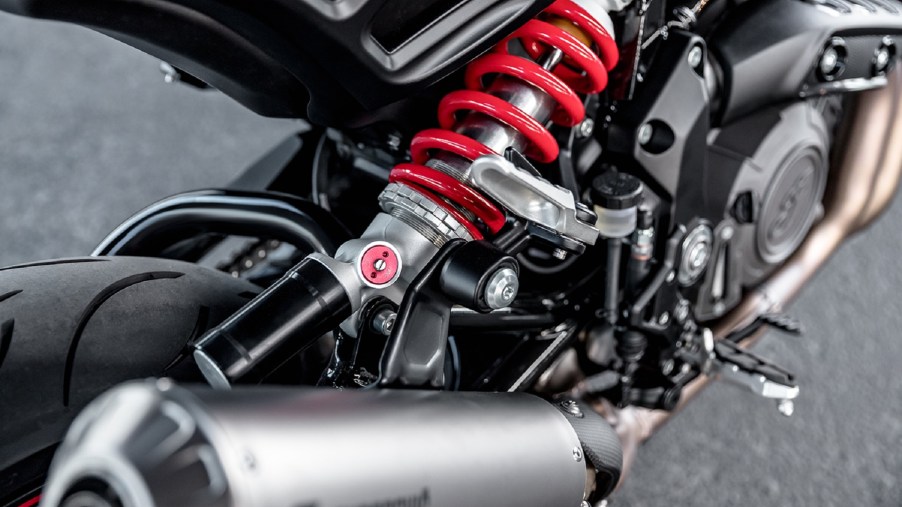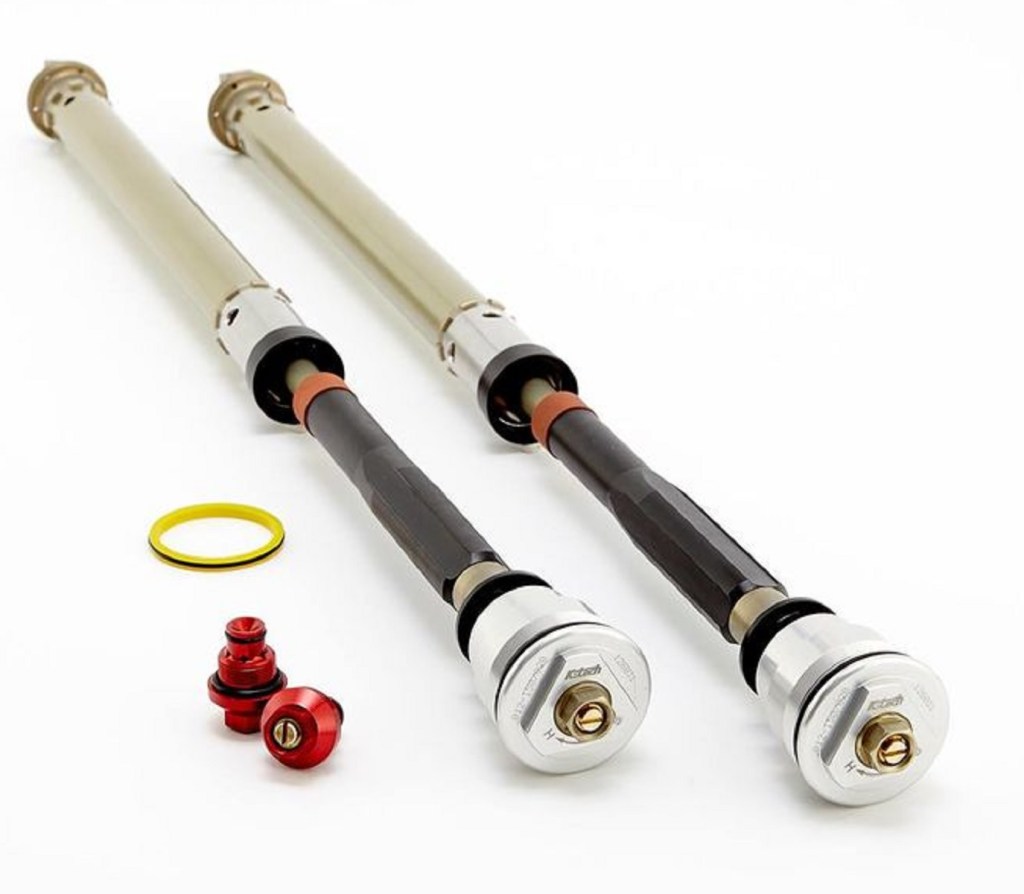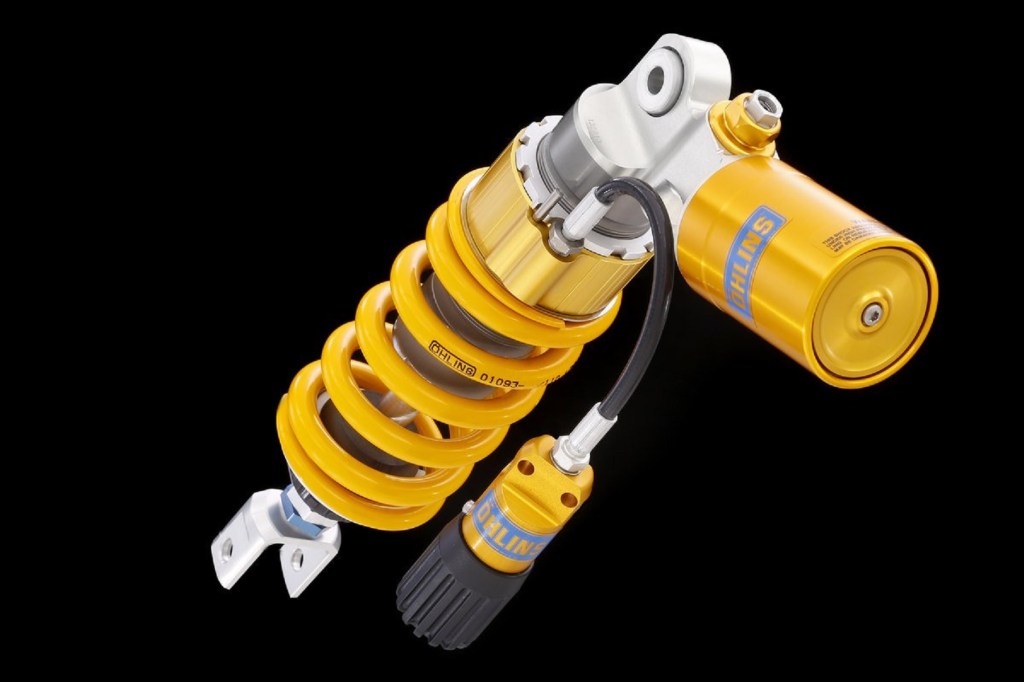
Should You Upgrade Your Motorcycle Suspension?
From different wheels to grippier tires and beyond, there’s a myriad of ways to modify your motorcycle’s performance. And while adding a supercharger or cutting curb weight helps boost speed, there are other options. For example, fitting your motorcycle with upgraded suspension components. But is it necessarily a worthwhile investment?
How does your motorcycle suspension work?

Your bike’s suspension is split into two parts. In front are the forks, which work much the same as a car’s shock absorbers, RideApart explains. They typically consist of a coiled spring, a fluid chamber/damper, various seals, and often several adjustment-related components, Cycle World reports. Modern active and semi-active systems, like the ones on some Ducati bikes, replace the mechanical parts with electronically-controlled ones, Cycle World and Motorcyclist explain.
As for the actual motorcycle shocks—or, in some cases, a singular shock—they’re located in the rear. Whether dual or single, they’re basically identical to car shocks, with an external spring and a fluid damper. In the case of monoshock systems, they usually come with an additional mechanical linkage, essentially a compact system of pivots and levers, Motorcycle.com explains. And as with motorcycle forks, modern bikes are also starting to embrace electronically-controlled shocks.

Besides resembling the suspension on a car, motorcycle suspension performs the same duties. Namely, it lets the rider steer and control the bike by keeping the tires in contact with the ground, Cycle World explains. Plus, those springs and dampers we mentioned? They let the shocks and forks absorb impacts and external forces, such as from holes, changes in elevation, rocks, etc. That way, the tires stick to the riding surface, and neither the bike nor the rider gets upset.
Why do motorcycle riders upgrade their suspension?
Keeping the tires in contact with the road doesn’t just improve corner grip, though. The shocks and forks affect how your motorcycle responds to your inputs and how well it accelerates, RideApart and Cycle World explain. Upgrading them, therefore, can make your bike faster and sharper.
However, just like car suspension has performance- and comfort-oriented duties, so does bike suspension. Your motorcycle’s shocks and forks also determine how comfortably and how high it rides, RevZilla explains. The former is important regardless of what surface you ride on—even on a racetrack, stiffer isn’t necessarily better, Cycle World explains. And the latter is especially vital if you’re planning on going off-roading on your motorcycle. A skid plate only goes so far, after all.
In short, upgrading your motorcycle’s suspension often comes with several benefits. But before you start shopping for new shocks, know that they might not be necessary.
Before you invest in an upgrade, try adjusting your motorcycle shocks and forks
If your bike isn’t riding or handling like you want it to, it might be that the shocks and forks aren’t adjusted properly for you. A good suspension setup takes into account a rider’s weight and their riding style, MCN explains. And adjusting the settings can often make your bike handle and ride better. Plus, it’s something you and a buddy can do on your own with just a few hand tools.
The first step is setting your motorcycle’s sag, or how much the suspension squats when the bike’s standing still, RevZilla explains. This is measured both with you on and off the bike, and is adjusted by changing the preload, Motorcyclist explains. ‘Preload’ describes how much compression the suspension’s springs are under.
Increasing preload increases the amount of force needed to further compress the spring. Thus, you have less sag, which some riders describe as a stiffer ride, RevZilla reports. But it also prevents your motorcycle shocks from bottoming out over bumps, jumps, and under acceleration, LifeAtLean explains. Plus, it also changes how your bike reacts to steering inputs, as it also impacts overall geometry, Motorcyclist explains.
After preload and sag comes adjusting the compression and rebound damping. These change how quickly and smoothly your motorcycle shocks react to bumps, Motorcyclist explains. If your bike’s suspension offers compression and rebound adjustment, you’ll often see their respective knobs labeled as ‘COM’ and ‘TEN,’ respectively. The latter abbreviation is because rebound damping is often called ‘tension damping,’ Motorcyclist explains.
Is getting an upgrade worth it?
Naturally, not every motorcycle suspension system offers the same degree of adjustability. Although compression and rebound damping adjustment is common on high-end sportbikes, budget bikes sometimes even lack preload adjustment. And often, riders upgrade their suspensions precisely to gain more adjustability.
However, even if your motorcycle suspension isn’t very adjustable, there are ways to improve it without going for a full upgrade. You can change the springs for stiffer or softer ones, LifeAtLean explains. And even if you can’t adjust the fork settings, you can swap to a different fork oil, or even replace the shims and internal valves, Motorbike Writer reports.
Speaking of swapping the oil, it’s worth noting that motorcycle suspension parts do wear out over time. And often, refurbishing them with new replacement internals, including springs and oil, restores handling and ride quality. Plus, it’s possible to do this yourself, Jalopnik reports. However, it’s worth pointing out that some shocks and forks, particularly lower-end ones, can’t be repaired like this, Bennetts reports.
Regarding upgrade costs, that depends on both the bike in question and the suspension manufacturer. Plus, what exactly you’re upgrading. For example, an Ohlins monoshock for my 2012 Triumph Street Triple R costs $600. A compatible K-Tech one, though, costs $1295, RevZilla reports. As for the forks, a set of Ohlins springs costs $150. But a full K-Tech cartridge set, with preload, compression, and rebound adjustment, costs $1196, RevZilla reports.

Ultimately, choosing whether or not to upgrade your motorcycle suspension depends on your budget and end goal. If you can’t adjust your current setup to where you want it, a more adjustable system makes sense. Especially if your current shocks and forks need to be replaced anyway. But if you can tune your current bike shocks/forks, trying doing that first.
Follow more updates from MotorBiscuit on our Facebook page.


